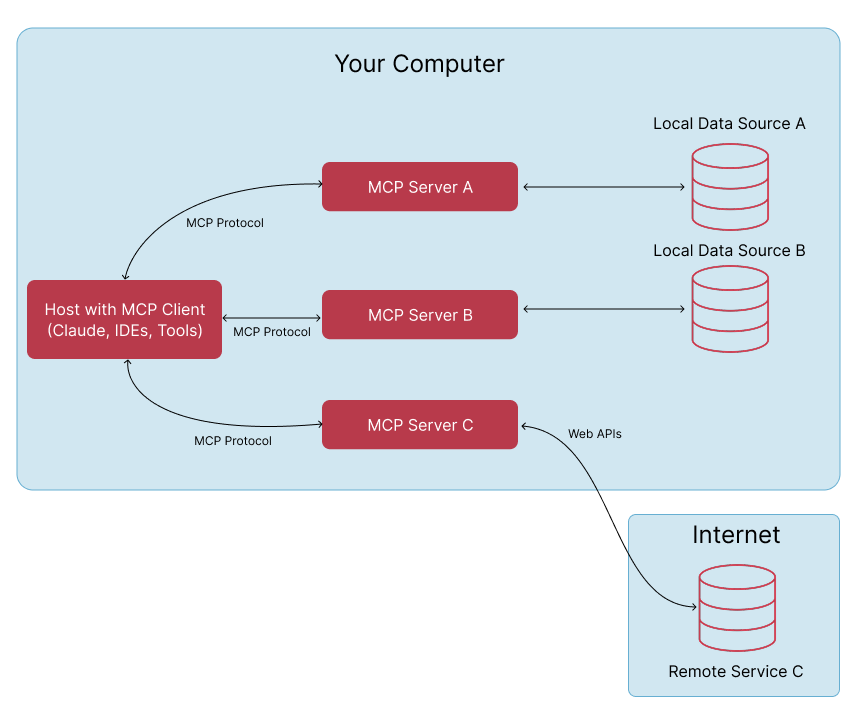Model Context Protocol: Why, What, and How
Making AI integrations effortless and universal
The Problem MCP Solves
If you've ever tried to get an AI model to interact with your company's data, you already know the pain. Every integration requires bespoke glue code, API credential wrangling, and hours of debugging before you can ask your AI assistant something as simple as, "How many sales did we close last quarter?"
If you think this sounds absurdly inefficient, congratulations—you've identified why the Model Context Protocol (MCP) exists.
MCP is an open standard that lets AI models connect to your data sources—databases, file systems, APIs, and tools—without requiring custom code for each integration.
Think of it like a USB-C port for AI applications: just as USB-C lets you connect your laptop to a charger, display, or external drive with a single standardized connector, MCP provides a unified way for AI models to access the data they need—securely and efficiently.
Why does MCP Matter?
Historically, getting an AI agent to work with your tools meant building one-off API integrations. Want your AI assistant to read emails? Time to integrate with Gmail’s API. Need it to access your CRM? Here comes another custom connector for HubSpot or Salesforce.
The result? A tangled mess of bespoke integrations, each requiring maintenance whenever APIs change.
MCP eliminates this headache by standardizing how applications provide context to large language models (LLMs). Instead of writing custom code for each data source, developers can simply connect their tools to an MCP-compliant server, and the AI model can query it dynamically.
The Architecture: Simpler Than It Sounds
MCP follows a client-server model with three key players:
The Host: This is the AI-powered application that wants to retrieve and use external data (e.g., an AI assistant inside your IDE or CRM).
The MCP Client: This sits inside the AI model and handles structured requests to MCP servers.
The MCP Server: This acts as a bridge, exposing external data sources (e.g., a PostgreSQL database, Google Drive, or a proprietary API) in a standardized way.
MCP also defines five core building blocks (called primitives) to ensure seamless integration:
Roots: for secure file access
Sampling: so AI can request data dynamically
Prompts: instructions to guide AI interactions
Resources: data objects the AI can reference
Tools: functions the AI can execute, like querying a database)
The upshot? Once a tool or data source is connected to MCP, any AI model that understands MCP can interact with it—without requiring custom-built integrations.
MCP vs. Traditional APIs: Why This Isn’t Just Another Wrapper
If you’re thinking, “Isn’t this just another API spec?”—not quite. The difference is in how AI models interact with data:
APIs are like separate doors: Each door requires a unique key and set of rules.
MCP is like a universal connector: No need to rewrite code every time you change tools.
No more API versioning nightmares: MCP allows dynamic adaptation, so AI models automatically adjust when tools change.
Self-documenting tools: With MCP, the interface itself serves as documentation. No more hunting through API docs to figure out how to structure a query.
The Business Implications
If you’re running a SaaS product, the strategic play here is obvious. The faster and easier you make it for AI models to interact with your product, the more likely it is that your product becomes part of the AI ecosystem.
Imagine you’re running a project management tool. With MCP, instead of developers hacking together integrations for every chatbot or AI assistant, you expose your functionality once—via MCP—and suddenly every AI application can interact with it. This is the equivalent of getting listed on an app store for AI models.
For enterprises, the benefit is even clearer. Instead of juggling brittle, bespoke API integrations, MCP lets AI systems talk to your existing infrastructure in a standardized way, reducing friction and cutting costs on maintenance.
The Bottom Line
The Model Context Protocol isn't just another technical standard—it's a fundamental shift in how AI systems will interact with our existing digital infrastructure.
The businesses that recognize this early and position themselves accordingly will have a significant advantage as AI becomes increasingly integral to daily operations.
As with many protocol-based innovations, the true value will emerge not from the protocol itself, but from the ecosystem that grows around it. Keep an eye on the MCP Marketplace and early adopters to spot the emerging opportunities.
If there's one thing I've learned from my time in the industry, it's this: when a new protocol solves a genuine coordination problem, betting on its ecosystem is rarely a mistake.






The AI tech stack keeps getting more and more layers. Its no longer a tech stack, its a tech pile at this point